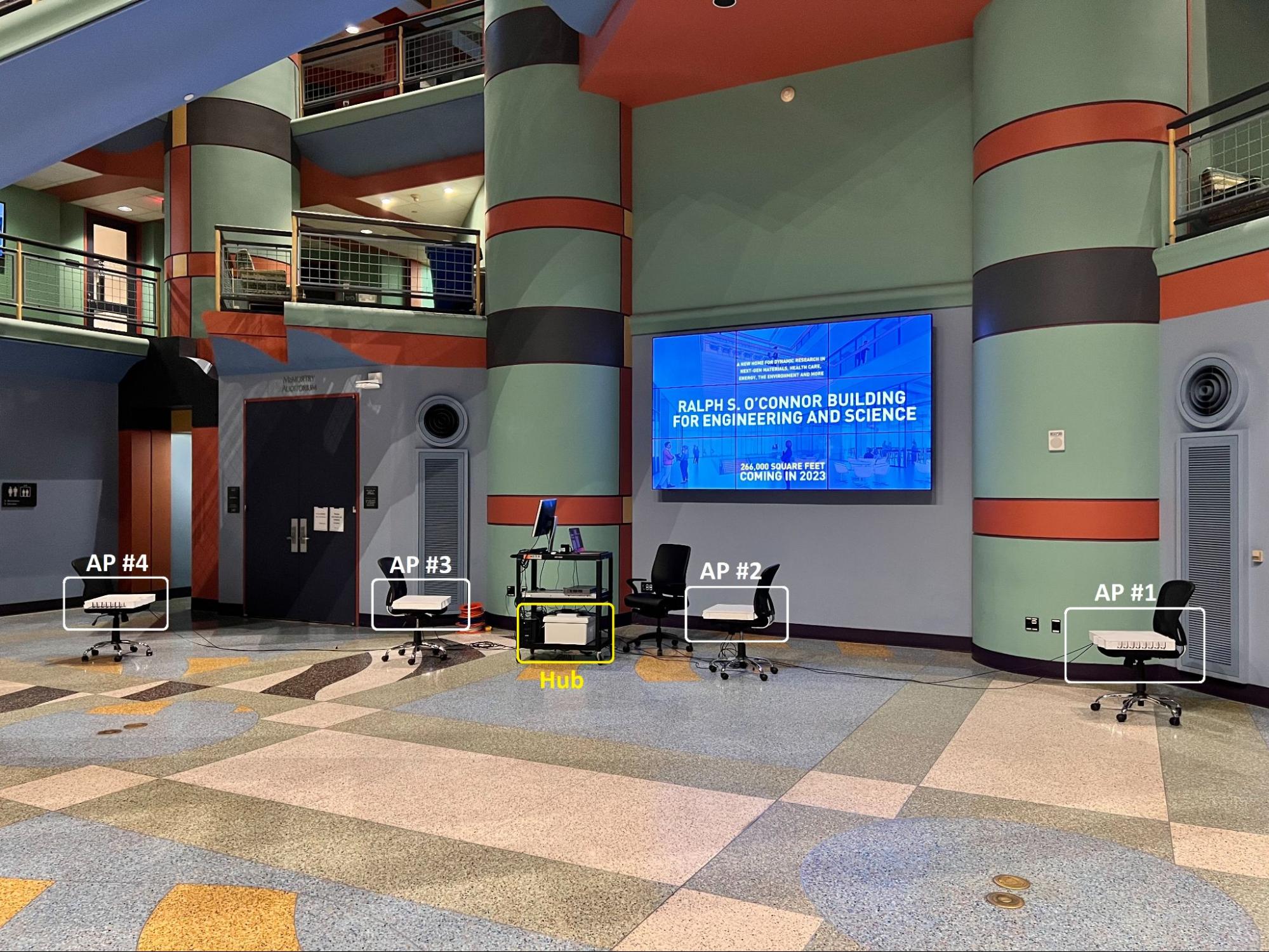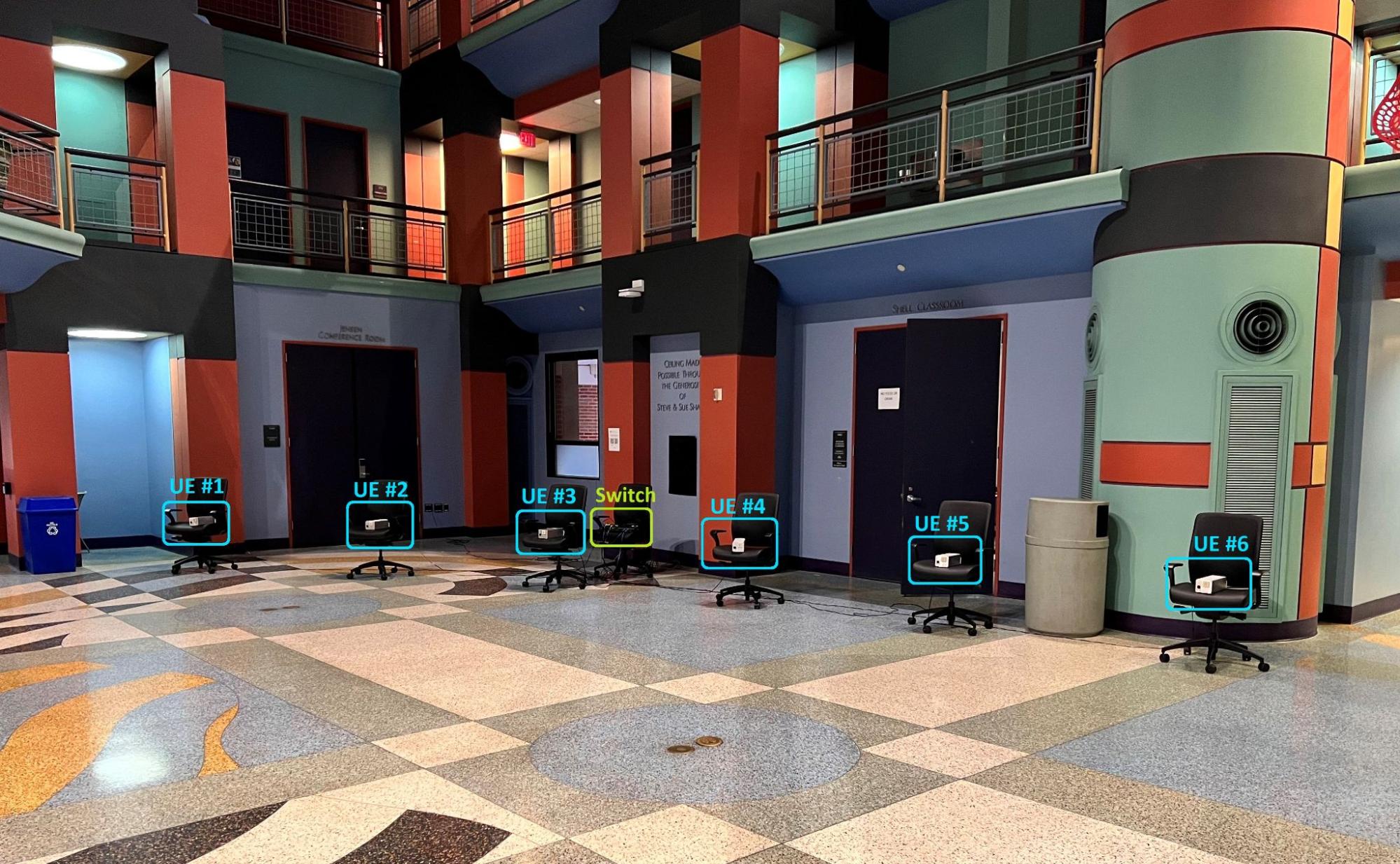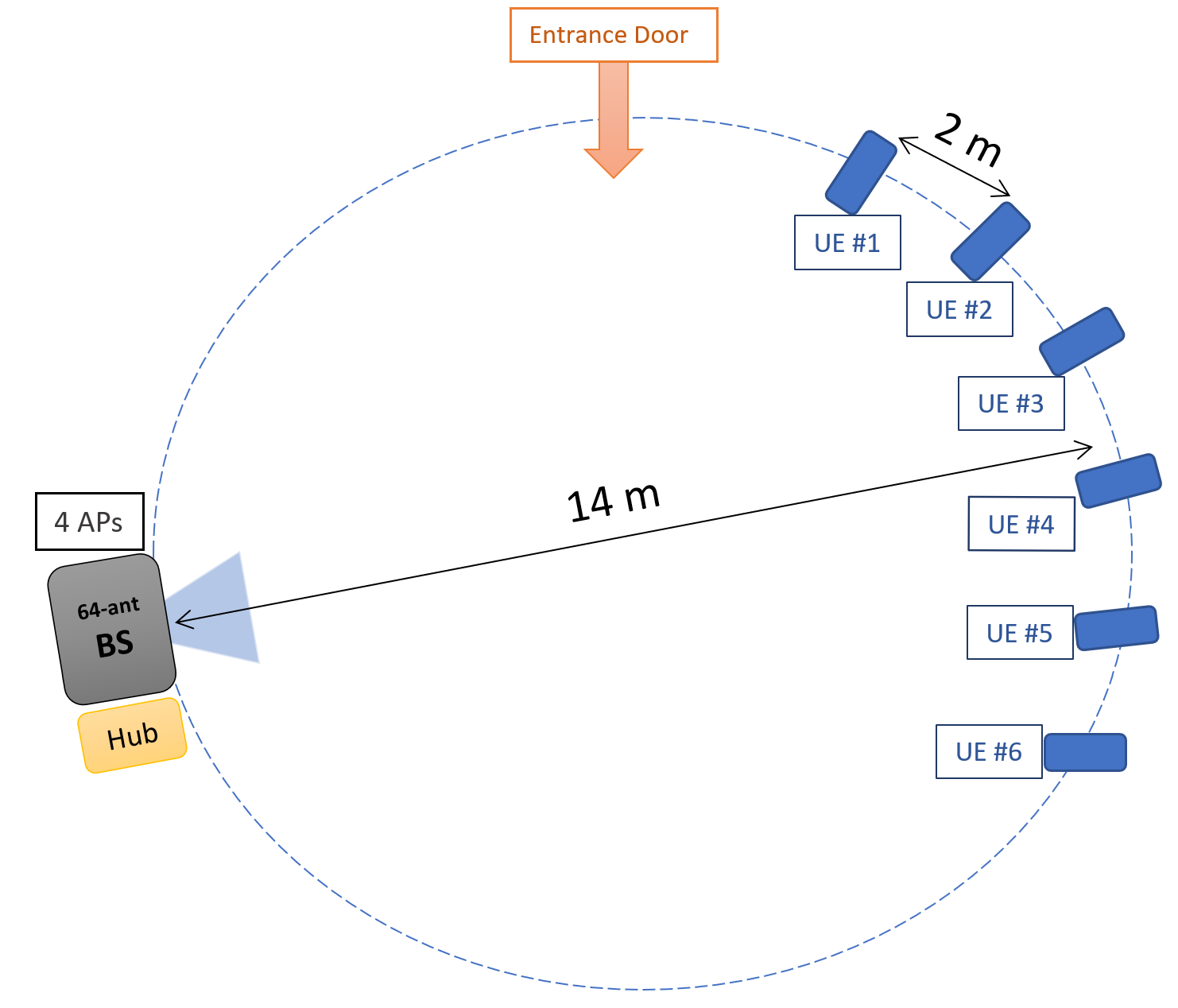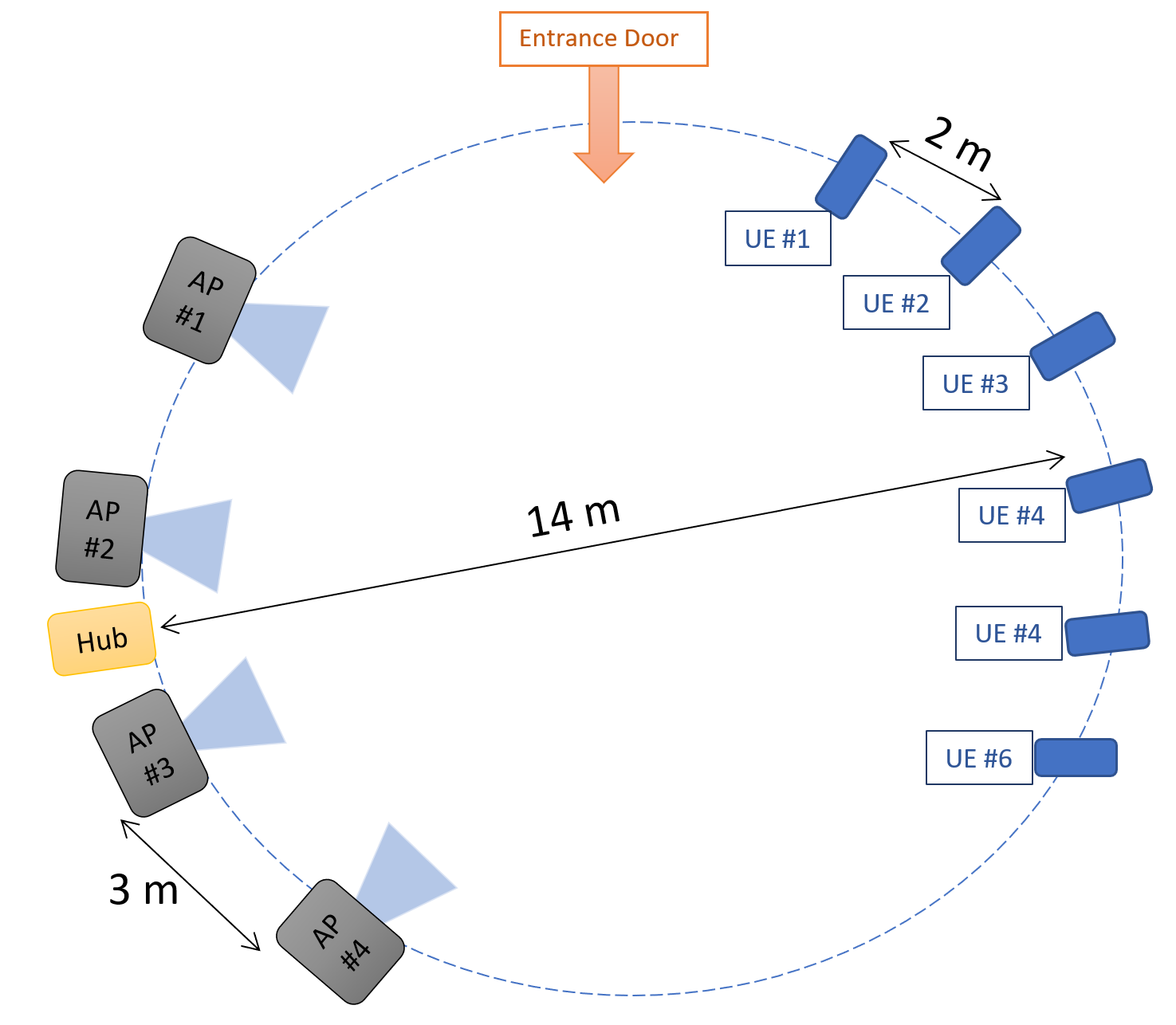Distributed Multi-User MIMO Datasets

Project Dataset
We conducted a massive MIMO channel measurement experiment in an indoor setting on the Rice University campus. The original purpose of this dataset was to study the effect of placement of mMIMO BS Arrays on performance in two scenarios of co-located and separated (distributed) as well as the effect of phase coherence among the arrays during channel measurement and data transmission.
Dataset Description
For our experimental setup, we used an indoor RENEW massive MIMO base station, equipped with four chains of Iris SDRs, consisting of 64 antennas in total. Each chain consists of 8 interconnected SDRs with dual-polarized antennas, forming a linear array that supports a total of 16 streams. All of these chains are connected to the central hub via a wired fiber link. These chains are considered as APs and are employed in two physical configurations: co-located and distributed. The clock signal in each AP is achieved through a daisy chain approach, where the initial SDR (head) of the chain disseminates the clock to all other SDRs in that AP. This clock at the head SDR can either be received from the hub (HUB-mode) or derived from the independent LO at the head SDR itself (LO-mode).

Co-Located: All four APs are stacked on top of each other, forming a 2D co-located 64-antenna massive MIMO array.
Distributed: APs are located 3 meters away from each other to emulate a physically distributed massive MIMO array.
HUB-mode: Perfect time and frequency are achieved via the hub.
LO-mode: The time trigger is shared by the hub, but each AP uses an independent LO, introducing a random CFO.
Users: Six standalone Iris SDRs are used as users, equally spaced on a circle with a diameter of 14m in an indoor hall. Each transmission attempt in each scenario was repeated twice, one on each of the UE RF chains (channel A & channel B).
Pilot and Data Symbols: We set up the frame schedule for the users so that each user sends time-orthogonal pilots and then all simultaneously transmit data OFDM symbols. We use the 802.11 LTS signal as the pilot symbol, which is used for channel estimation and beamforming matrix calculation. The format of the data OFDM symbols also follows the 802.11 standard, where the FFT size is 64. Out of the 64 subcarriers, 48 subcarriers carry data, 4 are pilot subcarriers, and the remaining are null subcarriers. Each uplink data slot includes 10 OFDM symbols. We try QPSK for modulating data subcarriers.
Scenario 1: Co-Located APs

Datasets are collected for the HUB-mode in the LoS (user antennas pointing to the BS) and NLoS (user antennas pointing to the wall) channel conditions.
- 61x1: 5 combinations of users
- 61x2: 3 combinations of users
- 61x4: 4 combinations of users
- 61x6: 1 combinations of users
Scenario 2: Distributed APs

Datasets are collected with the distributed placement of APs in both HUB-mode and LO-mode and with LoS channels from the users.
- 61x1: 5 combinations of users
- 61x2: 3 combinations of users
- 61x4: 4 combinations of users
- 61x6: 1 combinations of users
Code/Scripts
Channel measurement and dataset analysis software in included in the RENEWLab repository. In particular, the plot_hdf5 tool in RENEWLab can be used to visualize and post-process each HDF5 dataset. For more details on how to use this tool, please refer to the RENEW wiki page.
Data Copyright and License
Before you use the datasets, please read the Data Copyright and License Agreement below.
Rice University hereby grants you a non-exclusive, non-transferable license to use the data for commercial, educational, and/or research purposes only. You agree to not redistribute the data without written permission from Rice University.
You agree to acknowledge the source of the data in any publication or product reporting on your use of it.
We provide no warranty whatsoever on any aspect of the data, including but not limited to its correctness, completeness, and fitness. Use at your own risk.
You agree to acknowledge the following publication(s):
- Rahman Doost-Mohammady, Oscar Bejarano, Lin Zhong, Joseph Cavallaro, Edward Knightly, Z. Morley Mao, Wei Wayne Li, Xuemin Chen, Ashutosh Sabharwal, "RENEW: Programmable and Observable Massive MIMO Networks," 2018 52nd Asilomar Conference on Signals, Systems, and Computers, Pacific Grove, CA, USA, 2018, pp. 1654-1658, doi: 10.1109/ACSSC.2018.8645391.
in any publication or product reporting on your use of the data. If the data is not part of the IEEE Transactions on Machine Learning in Communications and Networking reference data, you also agree to acknowledge the additional source of the data, if applicable.
NOTE: Downloading, obtaining, and/or using the data in any means constitutes your agreement with these terms.
BibTeX entries:
@INPROCEEDINGS{8645391,
author={Doost-Mohammady, Rahman and Bejarano, Oscar and Zhong, Lin and Cavallaro, Joseph R. and Knightly, Edward and Mao, Z. Morley and Li, Wei Wayne and Chen, Xuemin and Sabharwal, Ashutosh},
booktitle={2018 52nd Asilomar Conference on Signals, Systems, and Computers},
title={RENEW: Programmable and Observable Massive MIMO Networks},
year={2018},
pages={1654-1658},
doi={10.1109/ACSSC.2018.8645391}}
Dataset
| # | File Name | Link | Size |
|---|---|---|---|
| 1 | All MU-MIMO Datasets | Datasets including multi-user uplink pilot and data with co-located and separated mMIMO BS arrays | 257 GB |